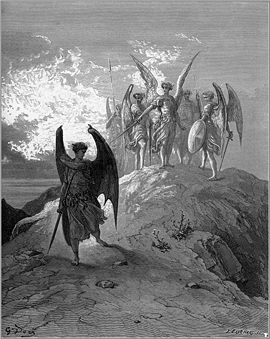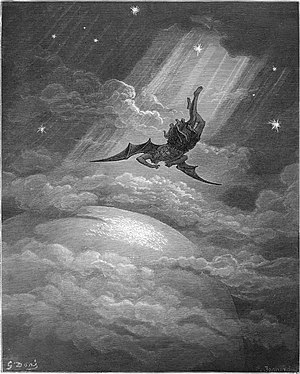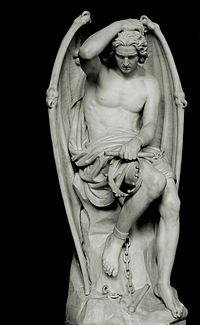Lucifer is a name frequently given to Satan in Christian belief. This usage as a reference to a fallen angel stems from a particular interpretation of Isaiah 14:3-20, a passage that speaks of someone who is given the name of "Day Star" or "Morning Star" (in Latin, Lucifer) as fallen from heaven.[2] 2 Peter 1:19 and elsewhere, the same Latin word lucifer is used of the morning star with no relation to Satan. However, in writings later than those in the Bible, the Latin word has often been used instead as a proper name for Satan.
In Latin, the word "Lucifer", meaning "Light-Bringer" (from lux, lucis, "light", and ferre, "to bear, bring"), is a name for the "Morning Star" (the planet Venus in its dawn appearances).[3] The Latin Vulgate version of the Bible used this word twice to refer to the Morning Star: once in 2 Peter 1:19 to translate the Greek word Φωσφόρος (Phosphoros),[4] and once in Isaiah 14:12 to translate the Hebrew word הילל (Hêlēl).[5] In the latter passage the title of "Morning Star" is given to the tyrannous Babylonian king, who the prophet says is destined to fall. This passage was later applied to the prince of the demons, and so the name "Lucifer" came to be used for Satan, and was popularized in works such as Dante Alighieri's Inferno and John Milton's Paradise Lost, but for English speakers the greatest influence has been its use in the King James Version of Isa 14:12 to translate the Hebrew word הילל, which more modern English versions render as "Morning Star" or "Day Star".
A similar passage in Ezekiel 28:11-19 regarding the "king of Tyre" was also applied to Satan, contributing to the traditional picture of Satan and his fall.
Latin name for the Morning Star

Lucifer is the Latin name[6] for the "Morning Star", both in prose and poetry, as seen in works by Marcus Terentius Varro (116–27 BC), Cicero (106-43 BC) and other early Latin writers[7]
Cicero wrote:
- Stella Veneris, quae Φωσφόρος Graece, Latine dicitur Lucifer, cum antegreditur solem, cum subsequitur autem Hesperos[8]
- The star of Venus, called Φωσφόρος in Greek and Lucifer in Latin when it precedes, Hesperos when it follows the sun.
And Pliny the Elder:
- sidus appellatum Veneris … ante matutinum exoriens Luciferi nomen accipit … contra ab occasu refulgens nuncupatur Vesper[9]
- The star called Venus … when it rises in the morning is given the name Lucifer … but when it shines at sunset it is called Vesper.
Poets also used the word "Lucifer". Ovid uses this name at least 11 times, as when he wrote:
- ... vigil nitido patefecit ab ortu
- purpureas Aurora fores et plena rosarum
- atria: diffugiunt stellae, quarum agmina cogit
- Lucifer et caeli statione novissimus exit.[10]
- Aurora, awake in the glowing east, opens wide her bright doors, and her rose-filled courts. The stars, whose ranks are shepherded by Lucifer the morning star, vanish, and he, last of all, leaves his station in the sky.[11]
Virgil wrote:
- Luciferi primo cum sidere frigida rura
- carpamus, dum mane novum, dum gramina canent[12]
- Let us hasten, when first the Morning Star appears,
- To the cool pastures, while the day is new, while the grass is dewy.
- Lucifer a Casia prospexit rupe diemque
- misit in Aegypton primo quoque sole calentem[13]
- The morning-star looked forth from Mount Casius and sent the daylight over Egypt, where even sunrise is hot.[14]
[edit] The Morning Star in Isaiah 14:12
The Book of Isaiah has the following passage:
- When the Lord has given you rest from your pain and turmoil and the hard service with which you were made to serve, you will take up this taunt against the king of Babylon: How the oppressor has ceased! How his insolence has ceased! … How you are fallen from heaven, O Day Star, son of Dawn! How you are cut down to the ground, you who laid the nations low! You said in your heart, "I will ascend to heaven; I will raise my throne above the stars of God; I will sit on the mount of assembly on the heights of Zaphon; I will ascend to the tops of the clouds, I will make myself like the Most High." But you are brought down to Sheol, to the depths of the Pit. Those who see you will stare at you, and ponder over you: "Is this the man who made the earth tremble, who shook kingdoms, who made the world like a desert and overthrew its cities, who would not let his prisoners go home?"[15]
The passage expressly refers to a "king of Babylon", a "man" who seemed all-powerful, but who has been brought low. Isaiah promises that the Israelites will be freed and will then be able to use in a taunting song against their oppressor the image of the Morning Star, which rises at dawn as the brightest of the stars, outshining Jupiter and Saturn, but lasting only until the sun appears. This image was used in an old popular Canaanite story that the Morning Star tried to rise high above the clouds and establish himself on the mountain where the gods assembled, in the far north, but was cast down into the underworld.[16][17]
The phrase "O Day Star, son of Dawn" in the New Revised Standard Version translation given above corresponds to the Hebrew phrase "הילל בן־שׁחר" (Helel Ben-Shachar) in verse 12, meaning "morning star, son of dawn". As the Latin poets personified the Morning Star and the Dawn (Aurora), as well as the Sun and the Moon and other heavenly bodies, so in Canaanite mythology Morning Star and Dawn were pictured as two deities, the former being the son of the latter.[18]
In the Vulgate, Jerome translated "הילל בן־שׁחר" (morning star, son of dawn) as "lucifer qui mane oriebaris" (morning star that used to rise early).[19] Already, as early as the Christian writers Tertullian and Origen,[16] the whole passage had come to be applied to Satan. Satan began to be referred to as "Lucifer" (Morning Star), and finally the word "Lucifer" was treated as a proper name. The use of the word "Lucifer" in the 1611 King James Version instead of a word such as "Daystar" ensured its continued popularity among English speakers.
Most modern English versions of the Bible (including the NIV, NRSV, NASB, NJB and ESV) render the Hebrew word as "day star", "morning star" or something similar, and never as "Lucifer", a word that in English is now very rarely used in the sense of the original word in Hebrew, though in Latin "Lucifer" was a literal translation.
[edit] Satan as Lucifer

The Jewish Encyclopedia states that the Lucifer myth was transferred to Satan already in the pre-Christian century, citing in support of this view the Life of Adam and Eve and the Slavonic Book of Enoch[20], where Satan-Sataniel (sometimes identified with Samael) is described as having been one of the archangels. Because he contrived "to make his throne higher than the clouds over the earth and resemble 'My power' on high", Satan-Sataniel was hurled down, with his hosts of angels, and since then he has been flying in the air continually above the abyss.[17]
However, it was among Christian writers that the identification of "Lucifer" with Satan had its greatest fortune. Tertullian ("Contra Marrionem," v. 11, 17), Origen ("Ezekiel Opera," iii. 356), and others, identify Lucifer with Satan, who also is represented as being "cast down from heaven" (Revelation 12:7-10; cf. Luke 10:18).[17]
The Tyndale Bible Dictionary states that there are many who believe the expression "Lucifer" and the surrounding context in Isaiah 14 refer to Satan: they believe the similarities among Isaiah 14:12, Luke 10:18, and Revelation 12:7-10 warrant this conclusion. But it points out that the context of the Isaiah passage is about the accomplished defeat of the king of Babylon, while the New Testament passages speak of Satan.[16]
A passage quite similar to that in Isaiah is found in Ezekiel 28:1-19, which is expressly directed against the king of Tyre, a city on an island that had grown rich by trade, factors alluded to in the text.[21] It too has been applied to Lucifer/Satan, because of some of the expressions contained in it.[22] But, since it does not contain the image of the morning star, discussion of it belongs rather to the article on Satan than to that on Lucifer.
The same holds for the picture of Satan in other books of the Old Testament as, for instance, in the book of Job, where Satan, who has been wandering the earth, has a discussion with God and makes a deal with him to test Job.
Joseph Campbell (1972: p.148-149) illustrates an unorthodox Islamic reading of Lucifer's fall from Heaven, which champions Lucifer's eclipsing love for God:
"One of the most amazing images of love that I know is in Persian – a mystical Persian representation as Satan as the most loyal lover of God. You will have heard the old legend of how, when God created the angels, he commanded them to pay worship to no one but himself; but then, creating man, he commanded them to bow in reverence to this most noble of his works, and Lucifer refused – because, we are told, of his pride. However, according to this Muslim reading of his case, it was rather because he loved and adored God so deeply and intensely that he could not bring himself to bow before anything else, and because he refused to bow down to something inferior to him (since he was made of fire, and man from clay). And it was for that that he was flung into Hell, condemned to exist there forever, apart from his love."
This interpretation of the satanic rebellion described in the Quran is seen by some Sufi teachers such as Mansur Al-Hallaj (in his 'Tawasin') as a predestined scenario in which Iblis-Shaitan plays the role of tragic and jealous lover who, unable to perceive the Divine Image in Adam and capable only of seeing the exterior, disobeyed the divine mandate to bow down. His refusal (according to the Tawasin) was due to a misconceived idea of God's uniqueness and because of his refusal to abandon himself to God in love. Hallaj criticized the staleness of Iblis' adoration. Excerpts from Sufi texts expounding this interpretation have been included along with many other viewpoints on Shaitan (by no means all of them apologetic) in an important anthology of Sufi texts edited by Dr. Javad Nurbakhsh, head of the Nimatullahi Sufi Order.[23]
The Sufi teacher Pir Vilayat Inayat Khan taught that 'Luciferian Light' is Light which has become dislocated from the Divine Source and is thus associated with the seductive false light of the lower ego which lures humankind into self-centered delusion.[24] Here Lucifer represents what the Sufis term the 'Nafs', the ego.
Liberal Christian scholars often deny altogether the existence of a personal being called "Satan", rendering the Lucifer story irrelevant.[citation needed] They argue that the name Satan itself (Hebrew: שָׂטָן) merely means "adversary" or "accuser", which may be a personification.[citation needed]
Mentions of the Morning Star in the Bible
In the Latin Vulgate the word "Lucifer" was used twice to refer to the Morning Star: once for "הילל" (hêlēl) in Isaiah 14:12 and once for the Greek word "φωσφόρος" (phosphoros) in 2 Peter 1:19.
"Lucifer" (Morning Star) also appears twice in the Vulgate translation of the Book of Job, once to represent the word "בקר"[25] (which instead means "morning") in Job 11:17, and once for the word "מזרות" (usually taken to mean "the constellations") in Job 38:32; and it appears also in Psalms 110:3 for "שׁחר" (dawn, the same word as in Isaiah 14:12).
Two references to the Morning Star in the Book of Revelation are not represented in the Vulgate by "lucifer". In both cases a circumlocution is used in the original Greek text, instead of the simple term "φωσφόρος", and a corresponding circumlocution is used in the Latin. Thus "stella matutina" is used for "ὁ ἀστὴρ ὁ πρωϊνός" in Revelation 2:28, which promises the morning star to those who persevere.
The Vulgate uses "stella matutina" to translated "ὁ ἀστὴρ ὁ πρωϊνός" (or, according to some manuscripts, "ὁ ἀστὴρ ὁ ὀρθρινός") in Revelation 22:16, where it is Jesus who is described as the morning star. An echo of this Biblical use is found in the Roman Rite liturgy, in which the Exultet chant in praise of the paschal candle refers to Christ as the morning star (in Latin lucifer):
| May the Morning Star which never sets | Flammas eius lucifer matutinus inveniat: |






No comments:
Post a Comment